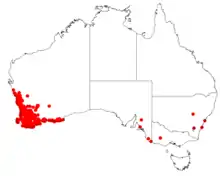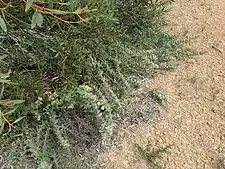| Harsh hakea | |
|---|---|
.jpg.webp) | |
| Scientific classification | |
| Kingdom: | Plantae |
| Clade: | Tracheophytes |
| Clade: | Angiosperms |
| Clade: | Eudicots |
| Order: | Proteales |
| Family: | Proteaceae |
| Genus: | Hakea |
| Species: | H. prostrata |
| Binomial name | |
| Hakea prostrata | |
 | |
| Occurrence data from Australasian Virtual Herbarium | |
| Synonyms | |
|
Hakea glabella R.Br. | |
Hakea prostrata, commonly known as harsh hakea,[2] is a species of shrub that is endemic to the south-west of Western Australia. It is a low-lying shrub with prickly leaves and groups of white or cream-coloured flowers in late winter and early spring.

Description
Hakea prostrata is a shrub which grows to between 1–3 m (3–10 ft) in height with spreading branchlets. The oblong-obovate stem-clasping leaves have prickly edges and a central vein. Plentiful sweetly scented white or cream flowers are produced in axillary racemose inflorescences between July and October in its native range.[3][4][5]
Taxonomy and naming
Hakea prostrata was first formally described in 1810 by botanist Robert Brown and published the description in Transactions of the Linnean Society of London.[6] The specific epithet (prostrata) is a Latin word meaning "down flat", "overthrown" or "laid low",[7] referring to the low growing, coastal form of this plant.[3][4]
Distribution and habitat
Harsh hakea is found from Geraldton to Esperance. It grows on hillsides, in shallow soil on granite outcrops, and stabilised sand dunes.[3][4]
Conservation status
Hakea prostrata is classified as "not threatened" by the Western Australian Government.[3]
References
- ↑ "Hakea prostrata". Australian Plant Census. Retrieved 30 September 2019.
- ↑ Archer, William. "Hakea prostrata". Esperance Wildflowers. Retrieved 30 September 2019.
- 1 2 3 4 "Hakea prostrata". FloraBase. Western Australian Government Department of Biodiversity, Conservation and Attractions.
- 1 2 3 Young, J A. Hakeas of Western Australia:A Field and Identification Guide. J A Young. ISBN 0-9585778-2-X.
- ↑ Holliday, Ivan (2005). Hakeas:A Field and Garden Guide. Reed New Holland. ISBN 1-877069-14-0.
- ↑ "Hakea prostrata". APNI. Retrieved 15 October 2018.
- ↑ Brown, Roland Wilbur (1956). The Composition of Scientific Words. Washington, D.C.: Smithsonian Institution Press. p. 481.